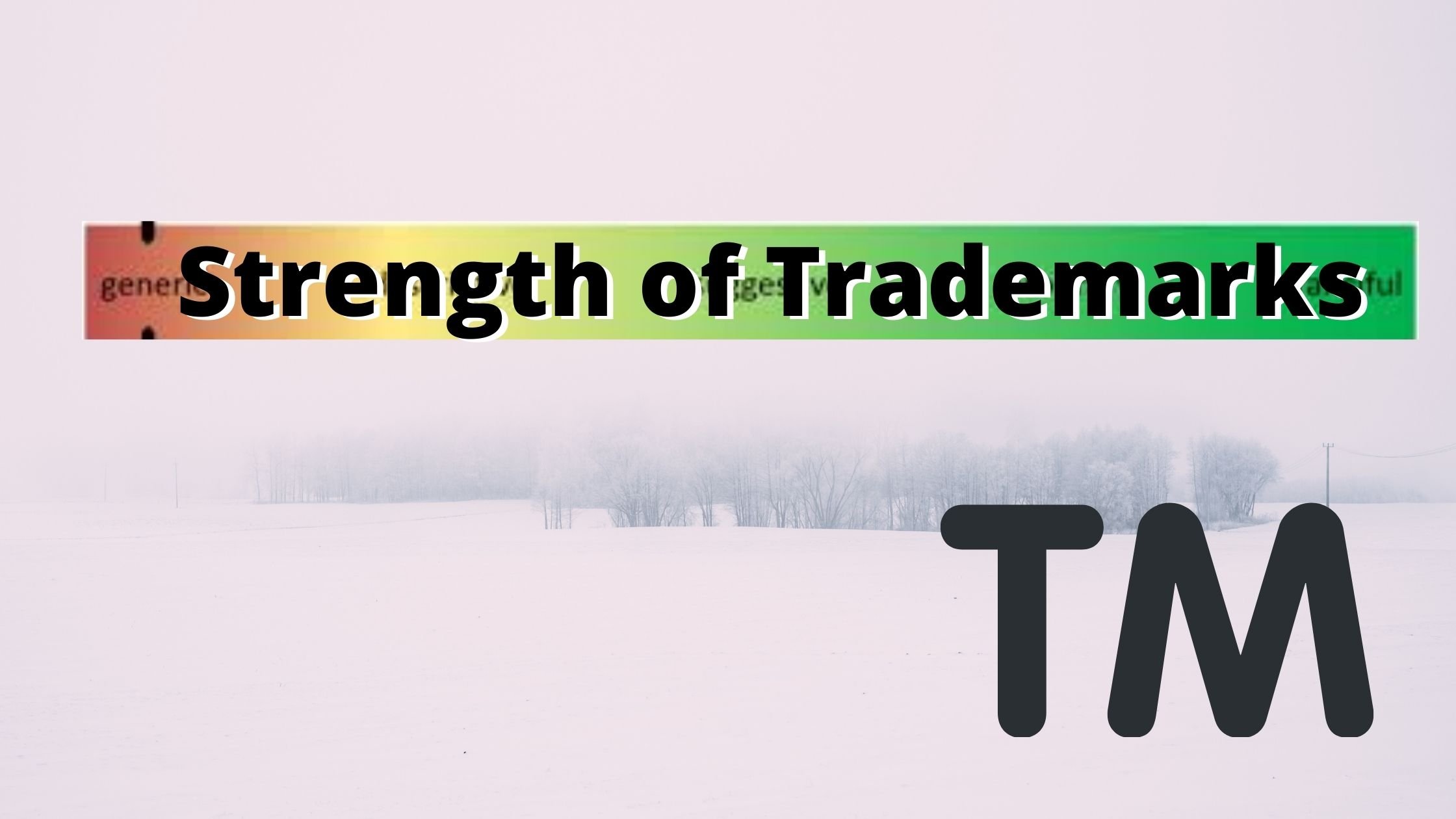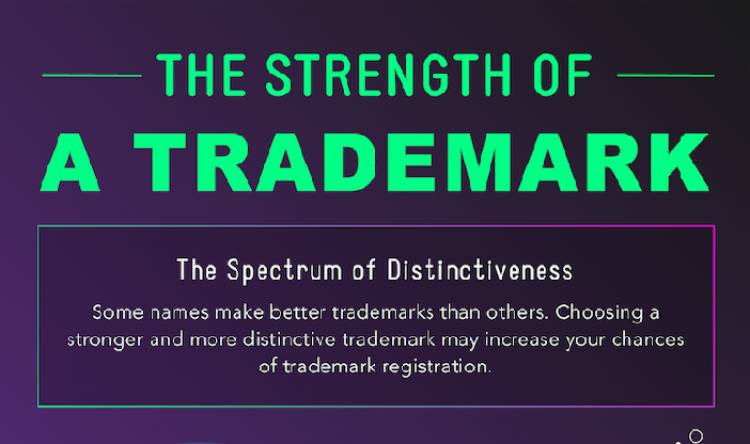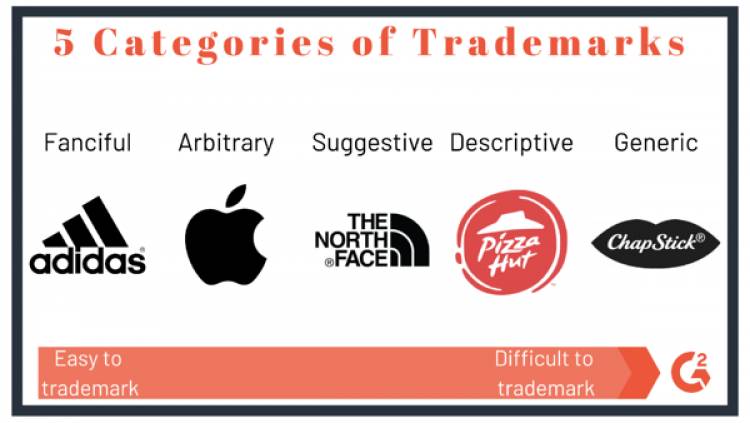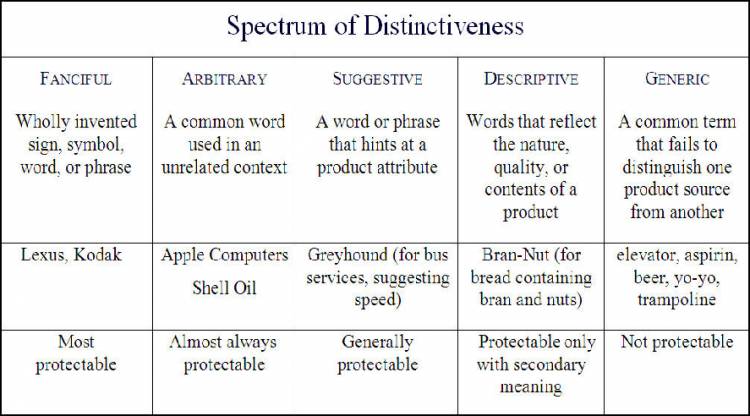STRENGTH OF TRADEMARKS
A gadget or device, (for example, a word or a logo) must be viewed as a trademark or a service mark on the off chance that it is particular. An unmistakable device/gadget is one that is equipped for recognizing the merchandise or services or administrations whereupon it is utilized from the products or services of others. A non-particular gadget is one that only depicts or names a trademark or nature of the goods or services. The uniqueness of a device/gadget can commonly be classified into one of five classifications which fall along a range of peculiarity.

STRENGTH OF TRADEMARKS

A gadget or device, (for example, a word or a logo) must be viewed as a trademark or a service mark on the off chance that it is particular. An unmistakable device/gadget is one that is equipped for recognizing the merchandise or services or administrations whereupon it is utilized from the products or services of others. A non-particular gadget is one that only depicts or names a trademark or nature of the goods or services. The uniqueness of a device/gadget can commonly be classified into one of five classifications which fall along with a range of peculiarity. From generally particular to least unmistakable, these classes are:

-
fanciful
-
arbitrary
-
suggestive
-
descriptive (including surnames)
-
generic
Devices or Gadgets that are fanciful, arbitrary, or suggestive are viewed as of particular enough to work as trademarks. Then again, if a device/gadget is descriptive or clear, the device can work as a trademark or service mark just in the event that it has gotten optional significance. Nonexclusive gadgets can never be a trademark.
The "strength" of a mark is resolved to some extent by where it falls on this range. Fanciful marks are viewed as more grounded than intriguing marks, and along these lines are allowed more prominent security by the courts.

FANCIFUL MARKS:
Fanciful marks are gadgets that have been created for the sole reason of working as a reserve (trademark) and have no other importance than going about as a mark.
EXXON, XEROX, KODAK are some good instances of the fanciful marks.
ARBITRARY MARKS:
An arbitrary mark uses a gadget having a typical implying that has no connection to the goods or services being sold. APPLE (for PC or laptops), LOTUS (for software), and SUN (for desktop and laptops) are some instances of Arbitrary marks.
SUGGESTIVE MARKS:
Suggestive marks are marks that recommend quality or normal for the merchandise (goods) and ventures (services). In spite of the way that suggestive marks are not as solid as fanciful or arbitrary marks, suggestive marks are unmistakably more normal because of the characteristic showcasing the preferred position of binds a mark to the item in a client's psyche. suggestive marks are frequently hard to recognize from descriptive marks (portrayed beneath) since both are expected to allude to the products and enterprises being referred to. Suggestive marks require some creative mind, thought, or insight to arrive at a resolution concerning the idea of the merchandise (goods). Descriptive marks permit one to arrive at that resolution without such creative mind, thought, or insight. Trying this qualification plainly is one of the most troublesome and contested territories of trademark law.
The accompanying marks can be viewed as suggestive:
-
MICROSOFT (suggestive of programming for microcomputers)
-
NETSCAPE (suggestive of programming which permits navigating the "landscape" of the Internet)
-
SILICON GRAPHICS (suggestive of realistic arranged PCs)
DESCRIPTIVE MARKS:
Descriptive marks (or all the more appropriately, "simply descriptive marks") are gadgets that only portray the services or goods on which the imprint is utilized. In the event that a gadget is simply descriptive, it's anything but an imprint by any stretch of the imagination, since it doesn't serve to recognize the wellspring of the goods or services. No trademark rights are conceded to simply descriptive marks. Miss-descriptive marks are similarly powerless. As clarified regarding suggestive marks above, descriptive marks are frequently hard to recognize from suggestive marks. Suggestive marks require some creative mind, thought, or insight to arrive at a resolution with respect to the idea of the merchandise. Descriptive marks permit one to arrive at that resolution without such creative mind, thought, or discernment. Trying this differentiation can be extremely troublesome. Just enlightening imprints can be enrolled governmentally on the Supplemental Register.

The accompanying nonexistent marks could be considered just descriptive for PC peripherals:
FAST BAUD for modems (depicting the speed of the modem);
104 KEYS for PC consoles (depicting the number of keys on a console);
LIGHT for convenient PCs (portraying the PC's weight); and
TUBELESS for PC screens (regardless of whether miss-descriptive for a screen that contains tubes).
Nonetheless, it is feasible for descriptive marks to "become particular" by accomplishing optional significance. Auxiliary significance demonstrates that in spite of the fact that the mark is all over a graphic of the products or services, shoppers perceive the mark as having a source showing capacity. When it very well may be demonstrated that a descriptive term or expression has accomplished this "second signifying" (the primary significance is the, for the most part, comprehended importance of the term or expression), a protectable trademark is created. Optional significance can be accomplished through long haul use or a lot of publicizing and exposure. The securing of auxiliary importance is frequently demonstrated using shopper reviews, that show that customers perceive the mark as a brand, for example, "FORD", instead of a graphic term, for example, "solid".
Instances of marks which may be viewed as graphic however have descriptive evolved optional importance include:
SHARP for TVs;
Computerized for PCs;
WINDOWS for windowing programming;
Global BUSINESS MACHINES for PCs and other business machines; and
Force COMPUTING for PCs dependent on the Power PC chip.
SURNAMES:
Marks that are fundamentally surnames, (for example, "SMITH SHOES" or "RODRIGUEZ COMPUTERS") are dealt with equivalent to descriptive marks under U.S. trademark law. Thus, surnames are not given insurance as a trademark until they accomplish optional importance through publicizing or long use. A trademark is "basically a surname" if the general population would remember it first as a last name, or on the off chance that it comprises of a surname and other material that isn't registrable.
When a surname accomplishes auxiliary significance, the mark is protectable as a trademark. Others can't utilize the mark on confusingly comparable products, regardless of whether they have a similar name. Hence, Jane McDonald couldn't open a café called "MCDONALDS", nor could Joel Hyatt open an inn under the name "HYATT MOTEL", since the imprints MCDONALDS and HYATT have accomplished optional significance.
GENERIC MARK:
Generic "marks" are gadgets that really name an item and are unequipped for working as a trademark. In contrast to descriptive marks, generic devices or gadgets won't turn into a trademark regardless of whether they are promoted vigorously to the point that auxiliary significance can be demonstrated in the mind of shoppers. The reasoning for making the classification of generic marks is that no producer or specialist co-op should be given the restrictive option to utilize words that generically recognize an item.
A legitimate trademark can become generic if the burning-through open abuses the mark adequately for the mark to turn into the generic name for the item. The perfect representations of the previous trademark that turned into the generic name for an item are ASPIRIN and CELLOPHANE. Current trademarks that were once viewed as contenders for turning out to be generic are XEROX and KLEENEX. XEROX has gone through a lot of publicizing cash to forestall abuse of its mark. Thusly, XEROX has likely to stay away from the deficiency (loss) of its trademark.
The accompanying words and expressions can be viewed as generic and in this way are unequipped for working as a trademark:
Cell phone;
Informal organization; and
Email.
Know more about, different types of trademarks, see the video below-
BY-
ANANYA PANDEY


![Apollo Hospitals Enterprises Ltd v Dr Dheeraj Saurabh [C.S.(Comm.Div) No.55 of 2023]](https://www.sonisvision.in/blogs/uploads/images/sonisvision_apollo_vs_dr_dheeraj_100x75_657a7dae2efdf.jpg)









